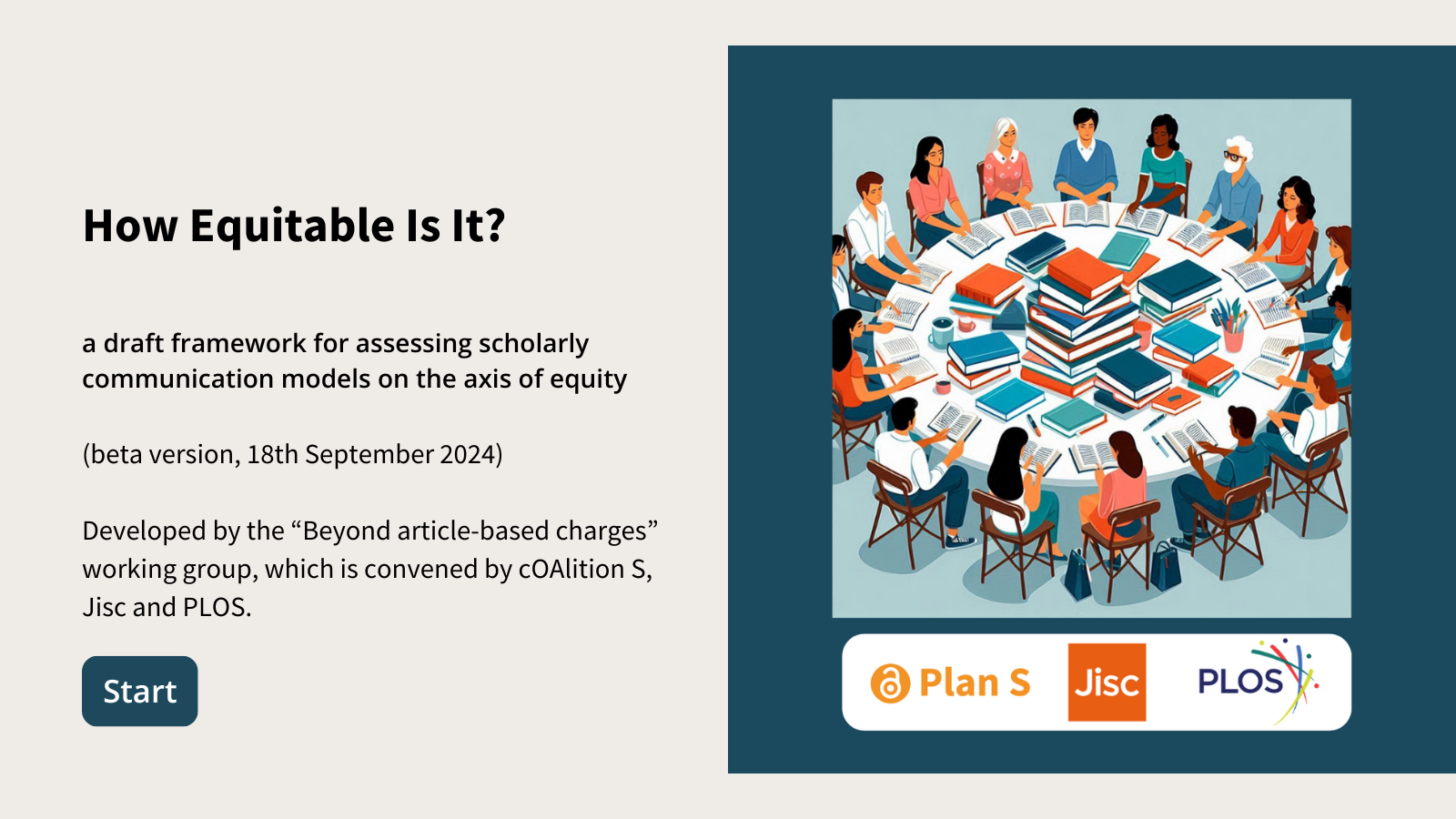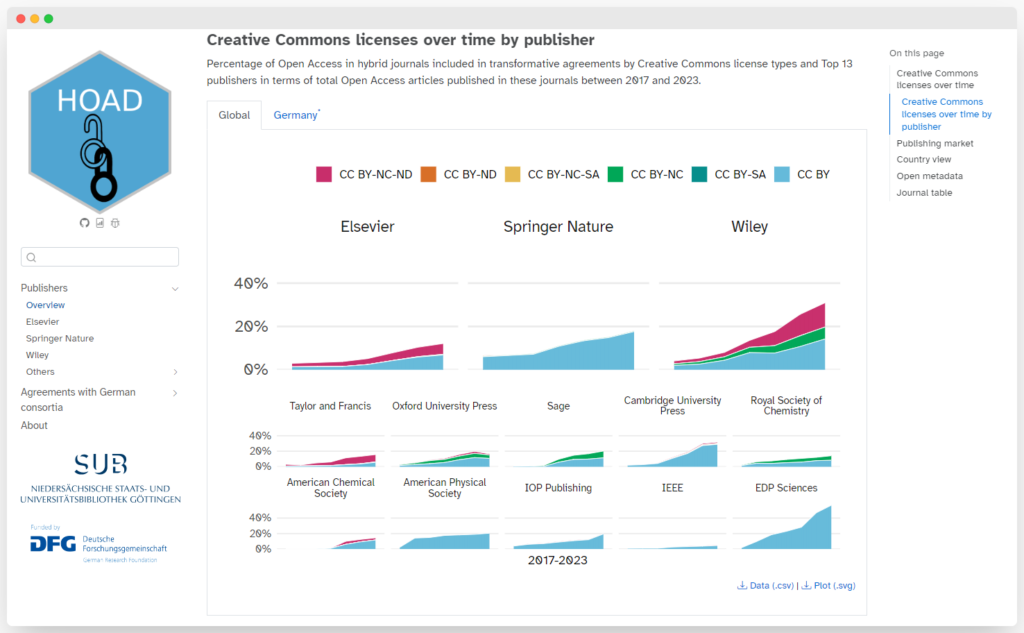Academic knowledge shouldn’t be hindered by economic disparities. However, many researchers today, particularly in developing countries, face significant barriers to participating in scholarly communication.
Traditional publishing models have often overlooked the vast economic differences between regions, creating an uneven playing field in scholarly communication. When researchers can’t afford to publish or access research, the entire scientific community loses valuable perspectives and contributions. On the contrary, models which are open and encourage participation in scholarly communication are more equitable than those which do not.
To address this challenge, Information Power, on behalf of cOAlition S, developed a new Equitable Pricing Framework to foster global equity in scholarly publishing.
Why a new pricing framework is needed?
Purchasing power varies significantly across the world, making standard pricing for products and services accessible in wealthier countries unaffordable in many others. Current pricing models in publishing fail to address these global disparities, as they do not take local purchasing power into account. This affects subscription costs, read-and-publish agreements, subscribe to open (S2O) agreements, collective funding models, article processing charges (APCs), and more.
While some publishers do offer discounts to some countries, there is no consistent or transparent method for determining appropriate discount levels. Often, the reasons behind these discounts are unclear, lost in outdated agreements or tied to specific or possibly arbitrary, decisions—such as a consortium’s negotiation strategy or a publisher’s attempt to expand into a new market. Whatever the origin, the process lacks transparency and equity.
Electronic Information for Libraries (EIFL) undertakes impactful work by negotiating deeply discounted agreements on behalf of its 33 member countries, but this initiative does not extend to all publishers or all developing nations. As a result, many countries still struggle to participate in scholarly communication due to unaffordable costs.
While some publishers offer waivers to authors in certain countries—typically those classified as Group A by Research4Life—this is not a universal solution. Many other countries, where the cost of APCs remains prohibitively high for researchers and institutions, are left out. There are many countries in the world that are wealthier than those classified in Group A but not wealthy enough to pay the prices paid by high-GDP countries, such as the USA, Australia or Norway.
Additionally, the practice of offering waivers can be problematic. It may be perceived as a form of charity, which risks being condescending and undermining the spirit of solidarity within the global research community.
Following a consultation with the funder, library/consortium, and publisher communities, this new pricing framework has been designed with the aim to promote greater transparency and inspire publishers and other service providers to implement more equitable pricing across different economies. This approach resembles successful models in other industries – similar to how the pharmaceutical industry has implemented tiered pricing based on countries’ capacity to pay, ensuring both equitable access and sustainable business models (Osman, F., & Rooryck, J. (2024). A fair pricing model for open access. Research Professional News).
The framework is adaptable, allowing publishers to implement changes gradually and in line with their specific circumstances. It can be applied to various pricing models, including article processing charges (APCs), subscriptions, and transformative agreements.
Key features of the framework include:
- Open, transparent data: utilizing World Bank International Comparison Program data, reflecting each country’s income and ability to pay.
- Banding: grouping countries into bands eases administration.
- Excel-based tool: allowing publishers to explore and set their own bands and differential prices using the same transparent data.
- Local currencies: raising invoices in local currencies where possible.
Where to learn more about the equitable pricing framework?
Do you want to learn more about how this framework can advance equity in scholarly publishing? Then join our webinar on the 16th of January 2025 between 17.00 and 18.00 CET. Our expert panel will include Miranda Bennett from California Digital Library, Franck Vazquez from Frontiers, César Rendón and César Pallares from Consorcio Colombia, Dave Jago and Alicia Wise from Information Power and Robert Kiley from cOAlition S.
To register your interest, please email info@informationpower.co.uk
*NEW* View the recording of the webinar on Youtube
You can also access the full report on the Pricing Framework to Foster Global Equity in Scholarly Publishing here https://zenodo.org/uploads/12784905, along with the More Equitable Pricing Tool and a set of frequently asked questions.
In 2023, PLOS was delighted to partner with cOAlition S and Jisc to establish a multi-stakeholder working group. Its goal was to identify business models and arrangements that moved away from article-based charges (i.e. APCs), enabling more equitable participation in knowledge-sharing.
In this blog post, we discuss the “How Equitable Is It” framework and how we, at PLOS, will use it as part of our efforts to support equitable participation in Open Science.
Background: the challenges of Open Access (OA) Publishing
We highlighted the challenges with article-based charges in the original Working Group call. The OA movement aimed to provide equitable access to research outputs, and the push to include the cost of publication in research budgets was intended to reduce the overall cost of access to published research.
Twenty years on, we see a number of unintended consequences for scholarly communication:
- APCs established as the predominant OA business model in those countries/regions/disciplines where this economic argument worked but also where they restricted participation for authors with limited funds.
- The rate of article growth leading to ever-increasing costs for funders and research-intensive institutions.
- The article embedded as the research output of value, blocking progress towards an Open Science ecosystem.
The “How Equitable Is it?” framework
So, where does the working group’s recently launched “How Equitable is it?” tool fit into all of this? For several years, we at PLOS have been working to make OA publishing more equitable by designing and implementing new non-APC business models, like Community Action Publishing and Global Equity. Both look to spread costs more equitably amongst those purchasing publishing services.
Community Action Publishing was designed to support our selective journals without the need for a high APC. Similarly, Global Equity does not work on the basis of a “per article” or “per unit” payment for publishing, while reflecting countries’ financial situations by relating to the World Bank Criteria. Both remove barriers to publishing for authors, while ensuring that everyone can read and reuse content (with proper attribution). Institutions in Research4Life (R4L) countries can participate in both models without charge.
While we’ve designed these models with equity in mind, the “How Equitable Is It?” Framework gives us the opportunity to demonstrate this to scholarly communication ecosystem stakeholders (funders, institutions, libraries, research communities) and to point the way forward for new equitable solutions.
Funders and research institutions can play a critical role in supporting the move to non-APC based business models. Viewed through an economic lens, funders and institutions–many of whom have equity in their mission statements–and librarians and consortia, who engage in collective negotiation on researchers’ behalf, can use this tool to assess publisher arrangements and models and steer investment or collaboration towards models that enable more equitable participation.
Importantly, the tool gives all scholarly communication stakeholders – publishers, funders, librarians, consortia and researchers – a common framework to discuss these aspects and together co-create more equitable solutions. Launching the framework as a beta version was purposeful to enable these stakeholders to give feedback and help steer its future iteration and evolution.
Supporting Open Science: future initiatives
Our work at PLOS in this area is not yet done. We are embarking on a new Research and Design project, with generous funder support, that will tackle two barriers that exclude many researchers from meaningfully participating in Open Science: the affordability of APCs and the lack of recognition for Open Science contributions beyond articles.
Our aim is to develop a new, integrated solution that enhances the visibility and discoverability of non-article research outputs, including data, code, and methods. Alongside this, grounded in principles of equity and price transparency, we will look to develop a sustainable, non-APC business model for all research outputs in collaboration with funders, libraries, and scientific institutions. The ”How Equitable is it” framework will be relevant to our design thinking, as we explore inclusive and sustainable solutions for the future of Open Science.
Just as the “HowOpenIsIt” guide, created in collaboration with SPARC and OASPA, gave researchers a framework to assess Open Access journals and guide their decisions about where they publish their research, we hope the “How Equitable Is It?” tool will enable funders, library consortia, and research communities to evaluate publisher models on the axis of equity and seek publishing solutions that directly align with their values. Please try it out and tell us what you think!
The current release of the “How Equitable Is It?” tool is a beta version, open for comments and improvement. Stakeholders in the academic publishing ecosystem are encouraged to test the tool and provide feedback by the 4th of November via the form https://coalitions.typeform.com/Equity-Feedback to help refine the criteria and increase its utility. The Working Group will review all input and publish a revised version in early 2025.
The Journal Comparison Service has been developed by cOAlition S to shed light on publishing fees and services. It enables those who procure publishing services to better understand how journals and publishers compare on a range of key indicators.
In this blog post, we provide an overview of the data held within the system, before looking in more detail at the 2022 data. Mindful of the fact that some of these data – especially those that relate to the prices charged for specific services – are considered confidential, we will aggregate and anonymise the data for this report.
Publisher participation: an overview
Table 1, below, provides an at-a-glance summary of publisher participation in the JCS. Between 2021 and 2022, the total number of publishers providing data increased slightly, from 28 to 33. Nevertheless, this number remains disappointingly low, especially in light of the increasingly louder calls for greater price transparency, as evidenced, for example in the recent conclusions from the Council of the European Union, the NIH plan on public access, and a statement from LIBER.
| JCS participation | 2021 | 2022 |
| Participating publishers | 28 | 33 |
| Participating journals | 2172 | 1871 |
| Publishers using the IP framework | 17 | 19 |
| Publishers using the FOAA framework | 11 | 14 |
| Journals using the IP framework | 2000 | 1668 |
| Journals using the FOAA framework | 172 | 203 |
Of the 28 publishers who shared data in 2021, all but one (Common Grounds Research Networks) continued to provide data in 2022; a retention rate of 96%.
The data also shows that although both frameworks are being used, the number of titles making use of the IP framework massively outweighs those using the FOAA framework, with some 1668 (89%) journals using the Information Power one in 2022.
Table 1 also shows that despite the slight increase in the number of publishers participating in the JCS, the total number of journals in the 2022 dataset fell from 2171 titles to 1871; a decline of 14%. Detailed analysis at the publisher level (see Annex A) shows that titles published by Wiley were primarily responsible for this reduction, with 23% fewer journals providing data. Most significantly, the overwhelming majority of 391 journals which did not permit Wiley to share their 2022 data, were titles which Wiley publishes on behalf of others, such as learned societies. Efforts will be made to reach out to these societies to encourage them to deposit data, either via Wiley, or by creating their own account on the JCS, in much the same way as EMBO Press have done.
2022 data
For the rest of this blog, we will focus exclusively on the 2022 dataset, and analyse it by APC, discipline, and price and service elements.
We recognise, however, that we can only report on data provided to the JCS and thus the analysis presented may not be applicable to all academic journals and publishers. That said, the dataset is from a diverse set of publishers, publishing across all disciplines and as such is likely to be indicative of general trends.
APC data
Recognising that some publishers may offer different priced APCs, the JCS asks publishers to provide a “low” and a “high” APC. Data provided for these two elements can be identical. Equally, if a publisher charges zero APCs (i.e. Diamond model) then this can also be recorded.
Taking the higher APC figure for 2022 – and having converted all APCs into US$[1], the currency most frequently used by publishers participating in the JCS – Figure 1 shows how the APCs vary over this dataset.
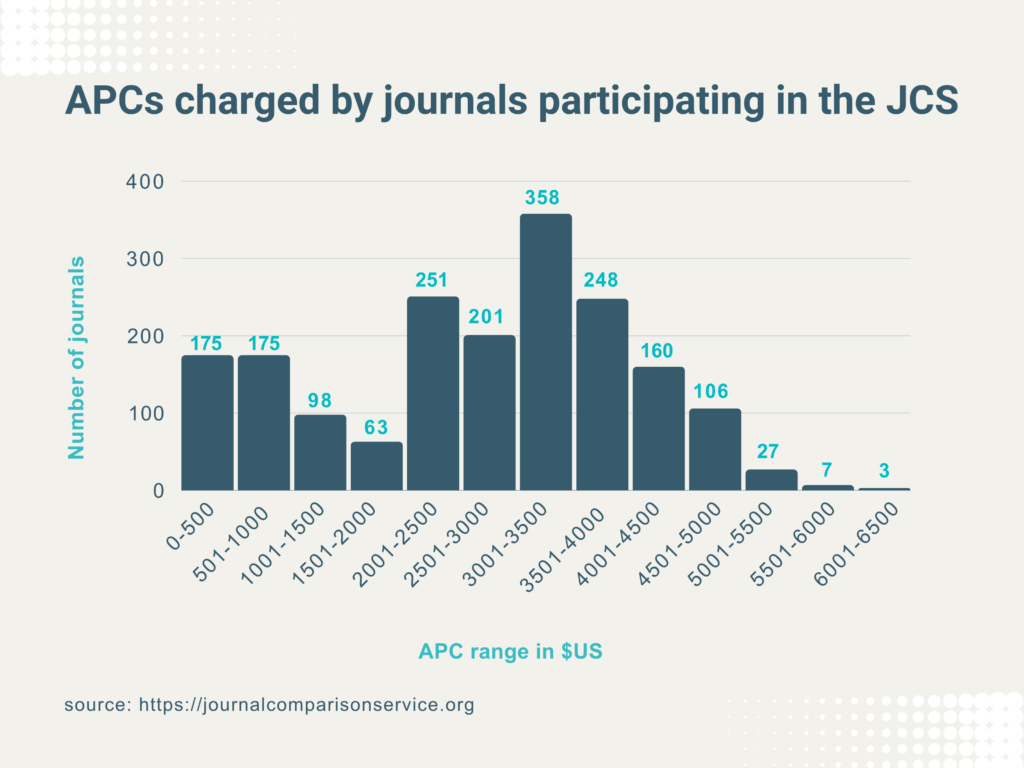
Figure 1: Distribution of APCs
In summary, as shown in Figure 2 below, 125 (7%) journals have an APC of zero, whilst 349 (19%) have an APC of less than $1000. In contrast, some 37 titles have an APC of $5000 or more. The median APC is $2940, whilst the average is $2648.
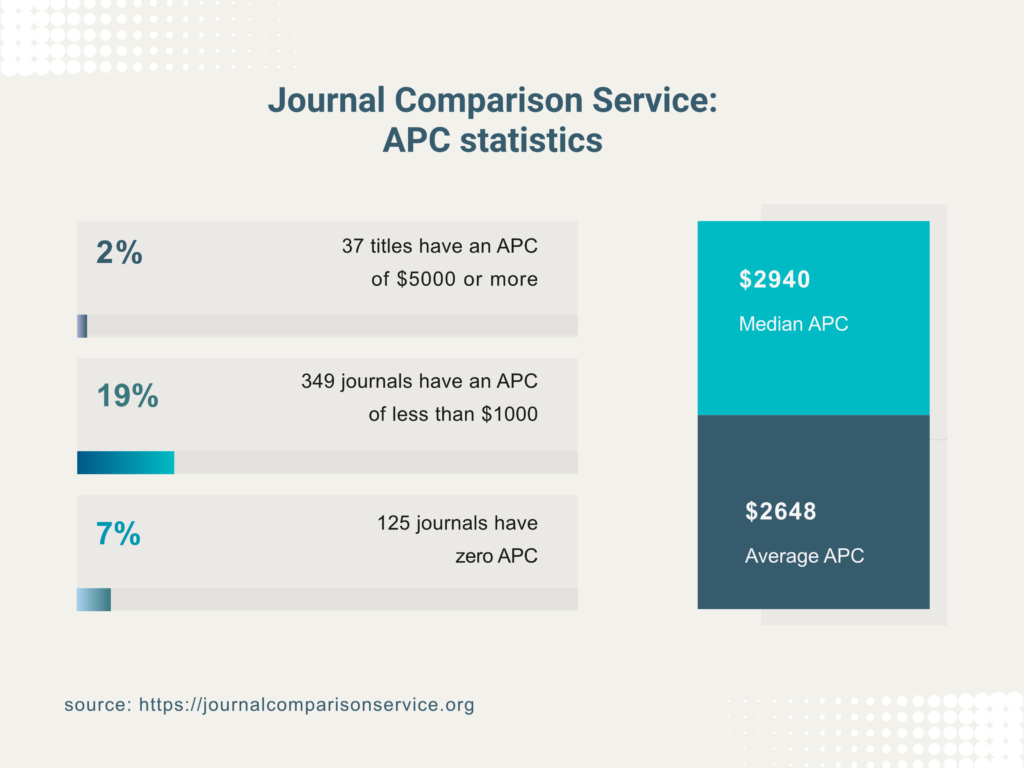
Figure 2: Journal Comparison Service: APC statistics
Disciplinary data
The JCS also requires publishers to provide information about the primary subject discipline of each journal, using the controlled vocabulary set out in the Frascati manual, 2015. The full disciplinary breakdown can be seen in Annex B, but for ease of understanding Figure 3 provides a summary.
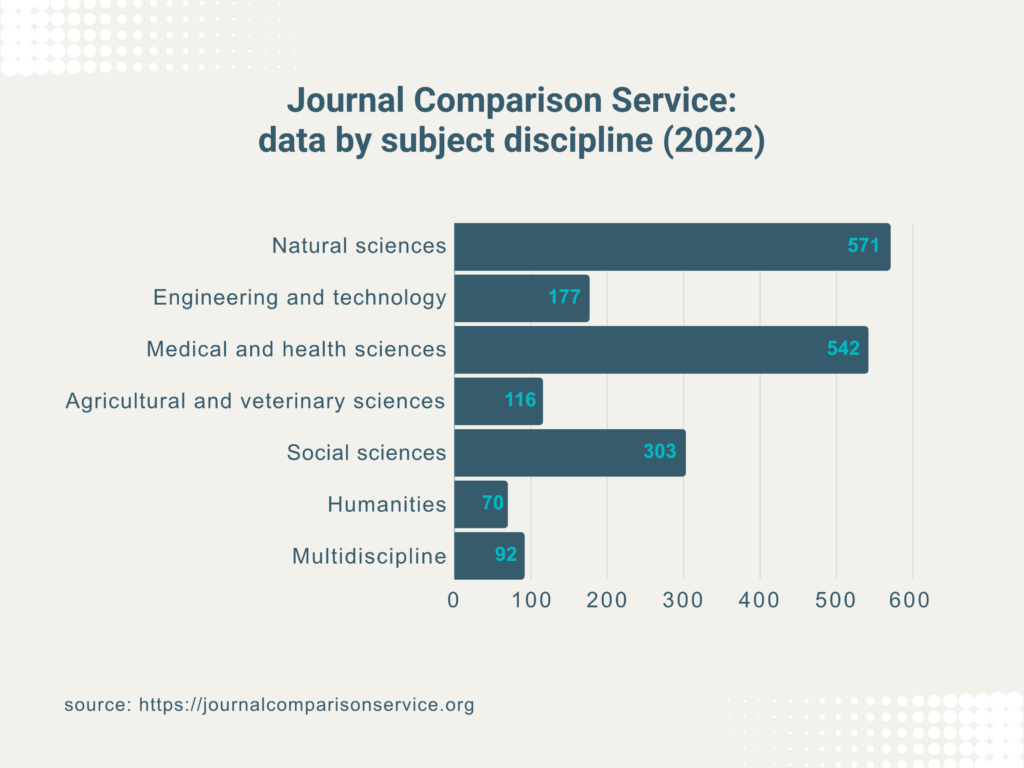
Figure 3: JCS data by subject discipline
To understand how disciplinary differences might impact the prices levied for different services, we looked at two broad disciplines, namely ‘medical and health sciences’ (referred to hereafter as MHS) and ‘social sciences / humanities’ (SSH). By combining journals in the humanities and social science disciplines, the number of journals totalled 393, broadly comparable with the number of journals in the MHS discipline. It also ensured that we were comparing similar number of publishers; 10 for the MHS journals, and 12 for the SSH titles.
APCs by discipline
Table 2 provides a summary as to how APCs varied across these two datasets.
| Average APC | Median APC | No. titles with APC = $0.00 | APC range | |
| MHS titles (n=543) | $2792 | $3060 | 9 (2%) | $0 – $5300 |
| SSH titles(n=393) | $2519 | $2940 | 55 (14%) | $0 – $4940 |
The broadly similar average and median APCs across both disciplines is surprising, as the common perception is that APCs in SSH titles tend to be lower than in MHS journals. This, however, may be an artefact of the data and the fact that one publisher – Wiley (excluding Hindawi) – is responsible for publishing over 60% of all journals listed in the JCS.
The finding that 14% of all SSH titles in the JCS charge no APCs is broadly in line with other analyses on diamond publishing, which show that this equitable approach to OA is more common in SSH than in other disciplines.
Price & service data
One of the core functions of the JCS is to provide registered End Users with information as to how the various services that publishers provide – managing peer review, copy editing, marketing etc. – contribute to the total price charged.
This however, is made more challenging by dint of the fact that the JCS currently allows publishers to provide data using either the Information Power framework – developed specifically for the JCS – or one based on the Fair Open Access Alliance framework. Although there were sound reasons for supporting both frameworks – not least the fact that some publishers had already started to use the FOAA one – we now believe the time is right to review this decision. The JCS Advisory Panel will discuss a recommendation to move exclusively to the IP framework at their Spring 2024 meeting.
The analysis below uses data from those publishers who provided information using the IP framework.
Focusing on the two broad disciplines discussed above, the following findings emerged (Table 3).
| Service/Price element | MHS titles: n=526 | SSH titles: n=317 |
| Key service elements | ||
| Research articles published (median): | 101 | 52 |
| Acceptance rate (median/average): | 24%/27% | 21%/26% |
| Desk rejection rate (median): | 60% | 69% |
| Median number of reviews: | 2 | 2 |
| Median no. of days to first decision | 22 days | 32 days |
| Median no. of days to undertake peer review | 33 days | 64 days |
| Median no. of days from acceptance to publication | 20 days | 21 days |
| Price elements – publishers indicate what % of the price is spent on each element. (Table shows median data and thus may not add up to 100%) | ||
| Price Breakdown: Journal Community Development | 27% | 34% |
| Price Breakdown: Journal Submission on First Decision | 7% | 6% |
| Price Breakdown: Peer Review | 14% | 14% |
| Price Breakdown: Services Acceptance Publication | 15% | 12% |
| Price Breakdown: Services Post Publication | 2% | 1% |
| Price Breakdown: Platform Development Support | 5% | 5% |
| Price Breakdown: Sales Marketing | 10% | 8% |
| Price Breakdown: Author Customer Support | 2% | 2% |
Note: for definitions of what is included in each service/price element, see here.
Because of the need to aggregate and anonymise the data before publicly sharing it in this blog, Table 4 can only provide a flavour of the potential richness of the JCS.
That said, even at this level, we can see that the median time for SSH titles to make a first decision (desk reject or send a manuscript to peer review) is 32 days, compared with 22 days for MHS titles, whilst the time to manage the peer review process for SSH titles (64 days) is almost twice as long as it takes journals in the MHS disciplines to complete this activity.
In terms of the percentage of the price spent on providing the various services, there is very little difference (at this aggregate level) between the two disciplines. Interestingly, the percentage allocated to managing the peer review service – arguably the most critical service publishers provide – is identical at 14%.
The largest price element in both disciplines is allocated to the “Journal Community Development” price bucket, which is defined as “activities to establish or develop the journal so that articles can be submitted (i.e. identify a need for the journal, its aims and scope development, investment in funding for the field, editorial board costs, commissioning content, competitor analysis, benchmarking, policy development, and portfolio development)”. How useful this catch-all bucket is to those who make purchasing decisions is something the Advisory Panel will be asked to comment on.
Further analysis
As this piece has already made clear, the need to respect the sensitive nature of the JCS data limits what can be disclosed in a public forum. However, registered End Users – on the understanding that they do not share the data outside their organisation – are not subject to these restrictions: they can use the JCS to compare different publishers and different journals to help determine if the price they are being charged is commensurate with the services provided.
If you are involved in procuring publishing services but do not yet have an account on the JCS, applications can be submitted via: https://journalcomparisonservice.org.
Annex A – Publisher participation in the JCS
| Name of Publisher | 2021: No. of journals in JCS | 2022: No. of journals in JCS |
| About Science | 5 | 5 |
| Beilstein Institute | 2 | 2 |
| Bio-protocol [New in 2022] | 0 | 1 |
| Common Ground Research Networks | 66 | 0 |
| Company of Biologists | 5 | 5 |
| Copernicus Publications | 37 | 41 |
| eLife | 1 | 1 |
| EMBO Press | 4 | 4 |
| European Respiratory Society | 4 | 4 |
| F1000 | 4 | 4 |
| Frontiers | 126 | 168 |
| Hindawi | 220 | 235 |
| IWA Publishing | 14 | 14 |
| Institute of Slavic Studies [New in 2022] | 0 | 8 |
| International Union of Crystallographers | 10 | 10 |
| JMIR Publications | 25 | 29 |
| John Wiley | 1470 | 1125 |
| Journal of Universal Computer Science | 1 | 1 |
| Ledizioni | 4 | 7 |
| Meise Botanic Garden | 1 | 1 |
| National Institute of Telecommunications [New in 2022] | 0 | 1 |
| Nordic Africa Research Network [New in 2022] | 0 | 1 |
| Oekom | 3 | 3 |
| Open Library of Humanities | 24 | 24 |
| Pensoft Publishers | 42 | 42 |
| PLOS | 7 | 12 |
| Portland Press [New in 2022] | 0 | 7 |
| Polish Botanical Garden | 4 | 4 |
| PsychOpen GOLD [New in 2022] | 0 | 15 |
| Rockefeller University Press | 3 | 3 |
| Royal College of General Practitioners | 2 | 2 |
| Royal Society of Chemistry | 43 | 47 |
| Royal Society | 10 | 10 |
| Ubiquity Press | 35 | 35 |
| Total | 2172 | 1871 |
Annex B – JCS titles: breakdown by discipline
| Subject | No. of journals |
| 1. Natural sciences | 57 |
| 1.1 Mathematics | 31 |
| 1.2 Computer and information sciences | 27 |
| 1.3 Physical sciences | 50 |
| 1.4 Chemical sciences | 106 |
| 1.5 Earth and related environmental sciences | 90 |
| 1.6 Biological sciences | 186 |
| 1.7 Other natural sciences | 24 |
| 2. Engineering and technology | 45 |
| 2.1 Civil engineering | 8 |
| 2.2 Electrical engineering, electronic engineering, information engineering | 51 |
| 2.3 Mechanical engineering | 11 |
| 2.4 Chemical engineering | 8 |
| 2.5 Materials engineering | 11 |
| 2.6 Medical engineering | 7 |
| 2.7 Environmental engineering | 6 |
| 2.9 Industrial biotechnology | 1 |
| 2.10 Nano-technology | 3 |
| 2.11 Other engineering and technologies | 26 |
| 3. Medical and Health Sciences | 123 |
| 3.1 Basic medicine | 65 |
| 3.2 Clinical medicine | 173 |
| 3.3 Health Sciences | 162 |
| 3.4 Medical biotechnology | 8 |
| 3.5 Other medical sciences | 11 |
| 4. Agricultural and veterinary sciences | 8 |
| 4.1 Agriculture, forestry, and fisheries | 74 |
| 4.2 Animal and dairy science | 17 |
| 4.3 Veterinary Science | 17 |
| 5. Social sciences | 3 |
| 5.1 Psychology and cognitive sciences | 86 |
| 5.2 Economics and business | 99 |
| 5.3 Education | 18 |
| 5.4 Sociology | 44 |
| 5.5 Law | 9 |
| 5.6 Political science | 17 |
| 5.7 Social and economic geography | 10 |
| 5.8 Media and communications | 3 |
| 5.9 Other social sciences | 14 |
| 6.1 History and archaeology | 14 |
| 6.2 Languages and literature | 23 |
| 6.3 Philosophy, ethics, and religion | 21 |
| 6.4 Arts (arts, history of arts, performing arts, music) | 7 |
| 6.5 Other humanities | 5 |
| All disciplines | 6 |
| All HSS disciplines | 20 |
| All STEM disciplines | 66 |
| Total | 1871 |
[1] 1605 titles reported the APC in US$. 4 titles used CHF; 133 titles used EUR, 121 titles used GBP and 8 titles used PLN). Average exchange rate from Euro to USD in 2022: 1.0538 USD; Average exchange rate from GBP to Dollar GBP:USD 1.249458, Average exchange rate of CHF in 2022: 1.0481 USD. PLN APCs were 0.
The Journal Checker Tool (JCT) – a service developed by cOAlition S to help researchers identify Plan S-compliant publishing routes – has been further developed to provide users with the ability to search across all the ESAC-registered transformative agreements (TA’s).
In this brief post, we will discuss the rationale for providing this new functionality, explain how it can be used, and highlight some challenges we faced while ensuring user-friendly access to this data.
Why did we develop this new feature?
The primary use case for this new feature was to support cOAlition S staff in reviewing applications to the Journal Comparison Service (JCS) by End Users (i.e. libraries, consortia and funders). Under our agreement with participating publishers, JCS access is limited to institutions actively involved in negotiating OA publishing agreements.
To demonstrate this involvement, institutions can now easily reference transformative agreements they’re part of. This update ensures that cOAlition S staff have a streamlined way to verify that an institution applying for a JCS account actively participates in OA publishing agreements, facilitating the JCS account approval process.
Search functionality
The JCT TA search feature can be accessed at https://journalcheckertool.org/ta-search.
The enhanced JCT supports the following scenarios:
- Which ESAC-registered TA’s are accessible to researchers at a specific institution
- Which ESAC-registered TA’s include a specific journal
For example, figure 1 shows all the TA’s accessible to researchers at the University of Oxford, whilst Figure 2 shows which TA’s include The Lancet journal.
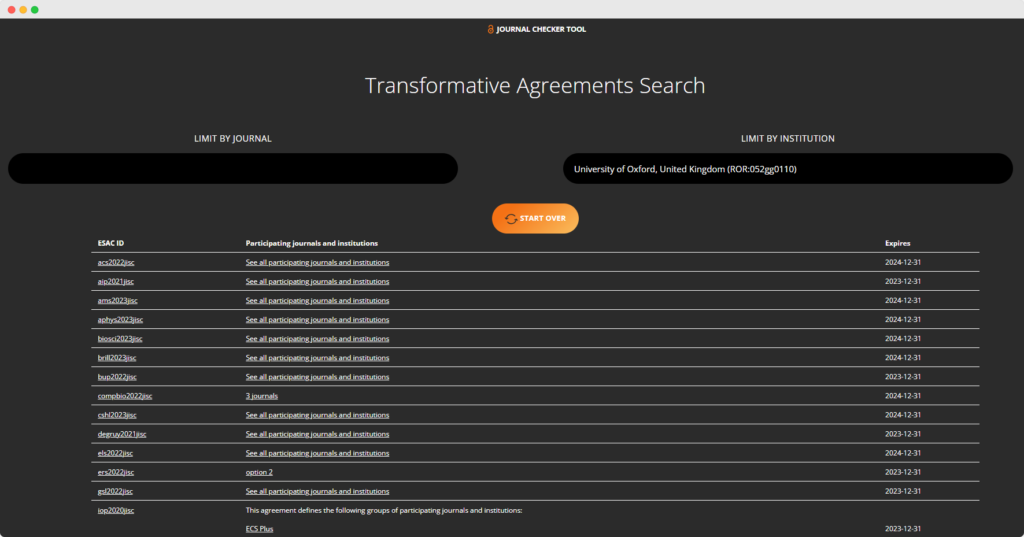
Figure 1: Screenshot showing a list of active TA’s accessible to researchers at the University of Oxford
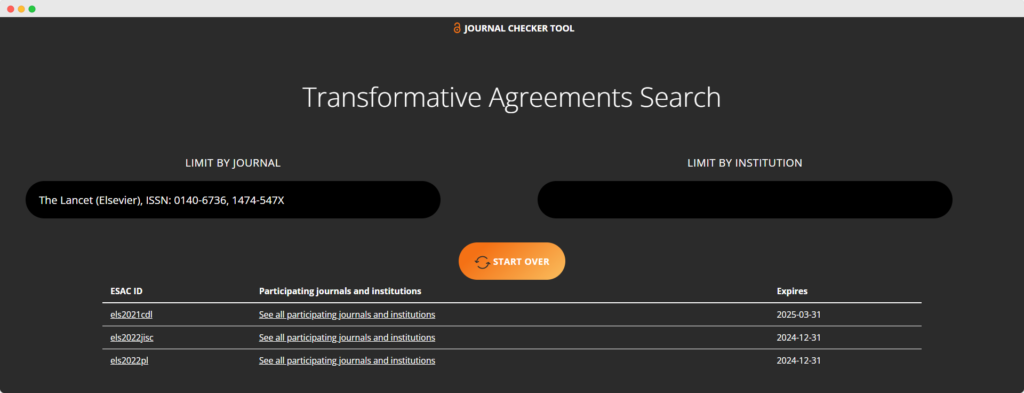
Figure 2: Screenshot showing a list of active TA’s which include The Lancet
Combining searches – for example, “is The Lancet part of a TA available researchers at the University of Oxford” (yes) – is also supported.
From the search results, the user can click through to the ESAC record and, perhaps more importantly, explore the JCT-created Google sheet which specifies which journals are covered by the agreement and which institutions have access to these titles.
These features highlight how journal-specific TA’s can be. For example, one might assume that a transformative agreement with a publisher like Springer Nature includes all of their titles. However, the JCT TA search feature reveals that this isn’t always the case. While the Spinger Nature journal Neurogenetics is included in 22 TA’s, the flagship journal Nature is included in just six.
Challenges
Arguably the biggest challenge in providing access to this dataset is making it clear that there is not always a 1:1 relationship between a TA and the list of journals/institutions which are included.
Take, for instance, the single ESAC agreement between VSNU and publisher Emerald. This agreement provides different institutions with access to a different set of journal titles, leading the JCT to create (and then index) 13 separate spreadsheets (see Figure 3).
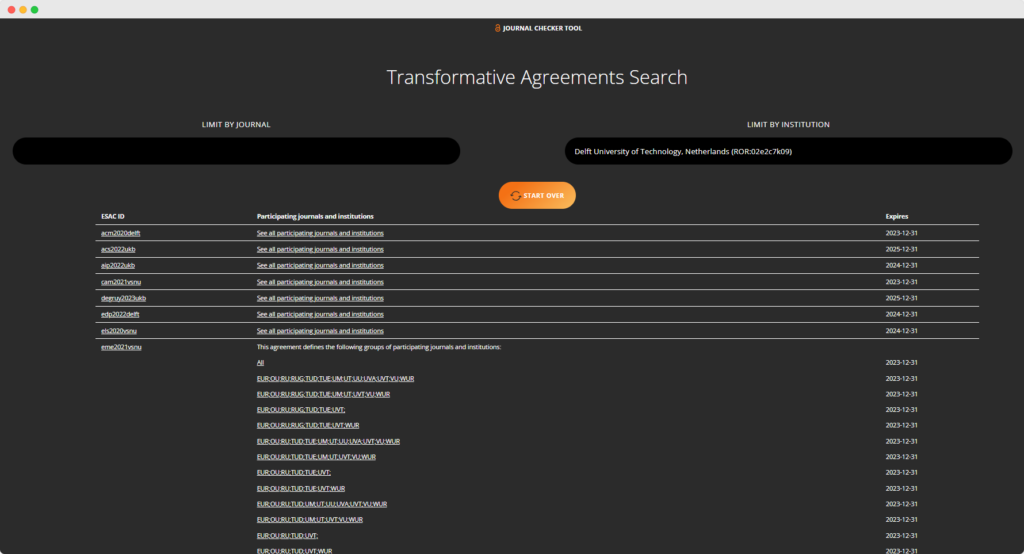
Figure 3: Screenshot showing how one TA between Emerald and VSNU results in 13 spreadsheets
Using this example, one can determine that whereas researchers at Erasmus University (signified by the EUR label) can read and publish in all the journals in the VSNU/Emerald agreement, researchers at Wageningen University & Research (signified by the WUR label) do not have a read/publish agreement for the titles specified in this, this, or this Google sheet.
In total, the 520 active TAs currently included in the ESAC database result in 626 separate Google sheets, which the JCT provides access to.
Feedback
We hope this development is of use and value to our stakeholder communities. If you have any comments, please let us know either via using the feedback button or by contacting me directly.
Robert Kiley
Head of Strategy, cOAlition S
We, at the Göttingen State and University Library, are pleased to introduce the Hybrid Open Access Dashboard (HOAD), an openly available data analytics tool designed for academic libraries and their consortia. Developed at the State and University Library Göttingen and funded by the German Research Foundation (DFG), HOAD combines open data from Crossref, OpenAlex, and the cOAlition S Journal Checker Tool. By doing so, the dashboard illustrates the ongoing transition of hybrid journal portfolios included in transformative agreements to full open access.
How does it work?
HOAD provides interactive charts and tables for exploring the openness of over 12,500 hybrid journals included in 400+ transformative agreements. These are derived from curated and publicly available cOAlition S Journal Checker Tool data. HOAD allows users to gain a general overview and analyse hybrid journal portfolios of selected publishers. Throughout the dashboard, users can compare the global hybrid journal landscape with the situation in Germany since 2017.
As an important aspect, users can explore hybrid open access across Creative Commons licences over time and compare licence types offered by publishers. Notably, Springer Nature journals predominantly adopted the CC BY licence, aligned with the preferences of Plan S, whereas Elsevier and Wiley hybrid journals still use the more restrictive CC BY-NC-ND licence for a substantial share of articles (see Figure).
Users can also explore variations in open access adoption among different countries. The view on the top productive countries shows that lead authors from the United States, China, and India published open access in hybrid journals to a much lesser extent compared to their European counterparts. In contrast, countries like Sweden, the Netherlands, Switzerland, the United Kingdom and Germany have achieved substantially larger open access shares, likely due to the wide implementation of transformative agreements.
Another important aspect assessed by HOAD is the availability of openly accessible metadata. Users can identify publishers that provide comprehensive metadata for their open access articles via Crossref. The metadata assessment includes open licences, abstracts, information about Text and Data Mining (TDM), authors’ ORCID, and funding. By highlighting gaps, HOAD supports library consortia in monitoring and negotiating improvements for open metadata in transformative agreements.
Screenshot showing the Hybrid Open Access Dashboard (HOAD) view on Creative Commons licences over time by publisher. Users can switch between the global view and the view on the consortia agreements for Germany. The side navigation allows searching and browsing of publisher-specific and Germany-specific hybrid journal portfolios.
Feedback gained
In March 2023, we announced the beta launch of HOAD through professional mailing lists and conducted public webinars to introduce the tool and gather feedback from potential user groups and other stakeholders.
During this process, we received valuable input from publishers asking about how to improve their metadata, specifically regarding open licences. With our regular data updates, we ensure that these metadata improvements are promptly incorporated into HOAD. Additionally, some publishers helped us to identify journals that were no longer part of their hybrid journal portfolios due to a change of publisher. This underlined the need to make transfers of journals between publishers more transparent in future releases.
We were delighted to engage not only with German consortia but also with representatives from other countries. National library consortia, who have been actively monitoring consortial transformative agreements, highlighted HOAD as a handy tool for benchmarking their progress with the general trend. They expressed interest in incorporating their own curated journal data, and suggested additional analytics about the use of green open access, funding acknowledgement, and open access spending. These aspects, not currently covered by HOAD, highlight promising areas of future development.
Both publishers and libraries had various inquiries regarding the data. Some requested easy data reuse options, while others sought clarification on our methodology. In response, we have implemented a download option for tables and charts to facilitate data reuse. To ensure transparency and reproducibility, HOAD data is openly available, along with the computational steps involved in compiling the data. Furthermore, we have commissioned a comparison of our data with Scopus and look forward to sharing the results in the near future.
What’s next?
As cOAlition S announces the end of financial support for transformative agreements by next year and the slow progress of open access in transformative journals persists, comprehensive monitoring approaches like HOAD are becoming even more crucial. While the project’s funding from the German Research Foundation has concluded, we remain committed to keeping the data up to date. We invite community engagement through Github and welcome discussions with national library consortia and other stakeholders to further customise HOAD to specific needs. Feel free to contact Najko Jahn.
We’ve worked hard to ensure the results given within the Journal Checker Tool (JCT) are as accurate as possible at this point. However, not all of the data being used by the JCT is ours to update. The tool is a partnership between data sources, with data updates being made in the data sources themselves. The JCT helpdesk will help to coordinate data update requests, but for some changes, particularly at the portfolio level, updates need to be submitted directly to the original data source, including e.g. DOAJ or the ESAC registry.
It’s in our collective interests to ensure that all the data used by the JCT is as fresh and complete as possible. We ask that publishers, consortia and institutions review their data within our sources such as DOAJ, our transformative agreement index and Shareyourpaper.org permissions to ensure that it reflects the current picture – something we know we don’t have right now for all journals. By taking action in the coming weeks, you are supporting researchers in enabling immediate access to research when Plan S launches on 1 January 2021.
Fully open access journals
Our data source for fully open access (OA) journals is DOAJ. If a journal isn’t indexed in DOAJ it won’t appear within the JCT. That’s the first thing for publishers to check for their fully Open Access (OA) titles. DOAJ has its own editorial process for determining whether or not a journal can be indexed in it and this process takes time. Most applications are processed in under 3 months but it can take up to 6 months in some cases. Publishers should start to submit their applications to DOAJ once they meet DOAJ’s Basic criteria. Once you are ready to apply, the application form is here: https://doaj.org/application/new. The JCT has access to data on titles that are in the process of applying to DOAJ.
The JCT will use the metadata held within DOAJ about a journal to determine whether it enables researchers to comply with Plan S. For example, we will look at whether the licence recorded within DOAJ is CC BY or equivalent. If not, then the journal will be identified as not being compliant. Therefore a publisher should check whether the licence options recorded within DOAJ for their titles show the most permissive licence. DOAJ are shortly to launch a new website and application form, with an updated metadata schema. DOAJ has published instructions on how publishers can update their records.
Journals under Transformative Agreements
We have built an index of Transformative Agreements (TAs) that have been registered within the ESAC Registry of Agreements. This index features information on the journals included within the agreement and the institutions that have subscribed to it. Agreements are listed within the index by their ESAC Registry Agreement ID, and the data can be downloaded from the JCT website for easy validation.
If you need to register your agreement in the ESAC Registry, you can do so here. Once uploaded to the registry it will be picked up as part of our TA data management process, which involves regular review cycles of agreements within ESAC and looking at the journals/institutions within each individual agreement. Consortia or publishers who wish to submit or update batches of data within the TA index should email jct[at]cottagelabs.zendesk.com.
Self-archiving
There are two routes to compliance through self-archiving within the JCT. The primary route is the journal’s own self-archiving policy, via the data source Shareyoupaper.org Permissions. Policies are monitored automatically and updated as required. However, if you would like to manually request an update you can do so here. If you’d like support and feedback while updating your policy, you can reach out to their team here.
If the data within Shareyourpaper.org Permissions does not reveal a policy that enables researcher compliance, then the JCT will look at whether the cOAlition S Rights Retention Strategy could be used as a route to compliance. Here the JCT will check if the funder of the research has implemented the Rights Retention Strategy. If so, Self-archiving via Rights Retention will be shown. For more information on Rights Retention see the related blog post: “4 things you should know about the Rights Retention Strategy and the Journal Checker Tool”.
Transformative Journals
Transformative Journals are subscription journals that have committed to transitioning to fully open access according to the criteria set out by cOAlition S. A list of currently approved transformative journals are available in csv format from the JCT website. Subscription journals who wish to be considered as transformative journals by cOAlition S, and thus the JCT, should apply here. cOAlition S will process applications upon receipt, with data transferred to the JCT within a fortnight once an application has been approved.
[New] JCT: update schedule
The table below shows the update schedule by which changes to publisher policies – and development on new cOAlition S approved arrangements – are made visible in the JCT. These timeframes may be affected by public holidays and the amount of data being handled at any one time.
| Item | Frequency |
|---|---|
| Transformative Journals | Once cOAlition S has approved a TJ application – and notified the publisher of this outcome – this information will be visible in the JCT within 10 working days |
| Transformative Agreement | The ESAC registry is crawled on a weekly basis. When we identify a new agreement, we reach out to consortia to obtain details of the titles covered by the agreements and which institutions have access. Once we have this data in the format we can use, this information will be visible in the JCT within 10 working days. |
| DOAJ updates | Changes to metadata in DOAJ (i.e. licence information) will be visible in the JCT within 5 working days of being made visible in DOAJ. |
| Publisher self-archiving policy updates | Changes to publisher self-archiving policies – as disclosed on the publisher web site – are identified by Shareyourpaper.org Permissions and made visible to the JCT within 3 working days. Should a publisher wish to notify us of a change to the policy they should do so here. Information provided via this direct route will be made visible to the JCT within 3 working days. |
We are delighted that the cOAlition S funded Journal Checker Tool (JCT) is released today. Although it is in open testing mode, this is a big milestone for us: we’re releasing the tool now to give you, the Plan S community, an opportunity to road test it.
The JCT is designed to support all researchers funded by a cOAlition S member in finding Plan S compliant “routes” through which to publish their research articles open access.
How does the Journal Checker Tool work?
Plan S allows three routes to compliance: through fully open access venues; through self-archiving, and through so-called transformative arrangements (which includes transformative agreements and transformative journals).
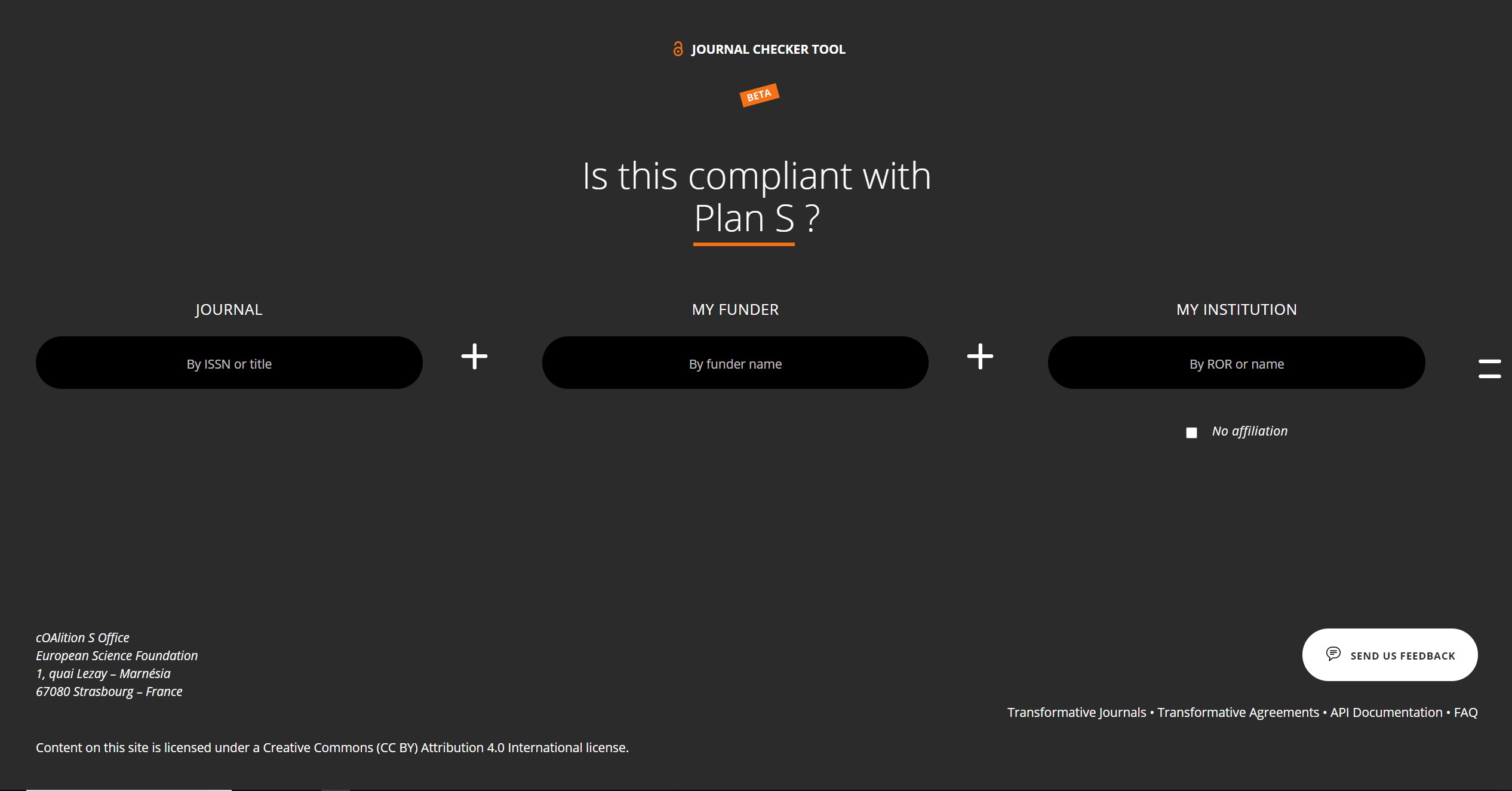
The Journal Checker Tool (JCT) allows a researcher to enter the name of their funder, the institution they are affiliated with, and the journal to which they plan to submit an article. The tool then checks if this combination of funder, institution, and journal offers any route to compliance with Plan S. It simultaneously checks 4 options:
- whether the journal is fully open access, in line with Plan S,
- whether it is included within a transformative agreement subscribed to by that particular institution,
- whether it is a transformative journal; or
- whether self-archiving is an available option, either via the publishers self-archiving policy or via the cOAlition S Rights Retention Strategy (RRS).
Our current criteria for compliance centres on whether a particular journal enables a researcher to publish an article under a CC BY licence without embargo, and retain sufficient copyright to enable compliance with open access policies.
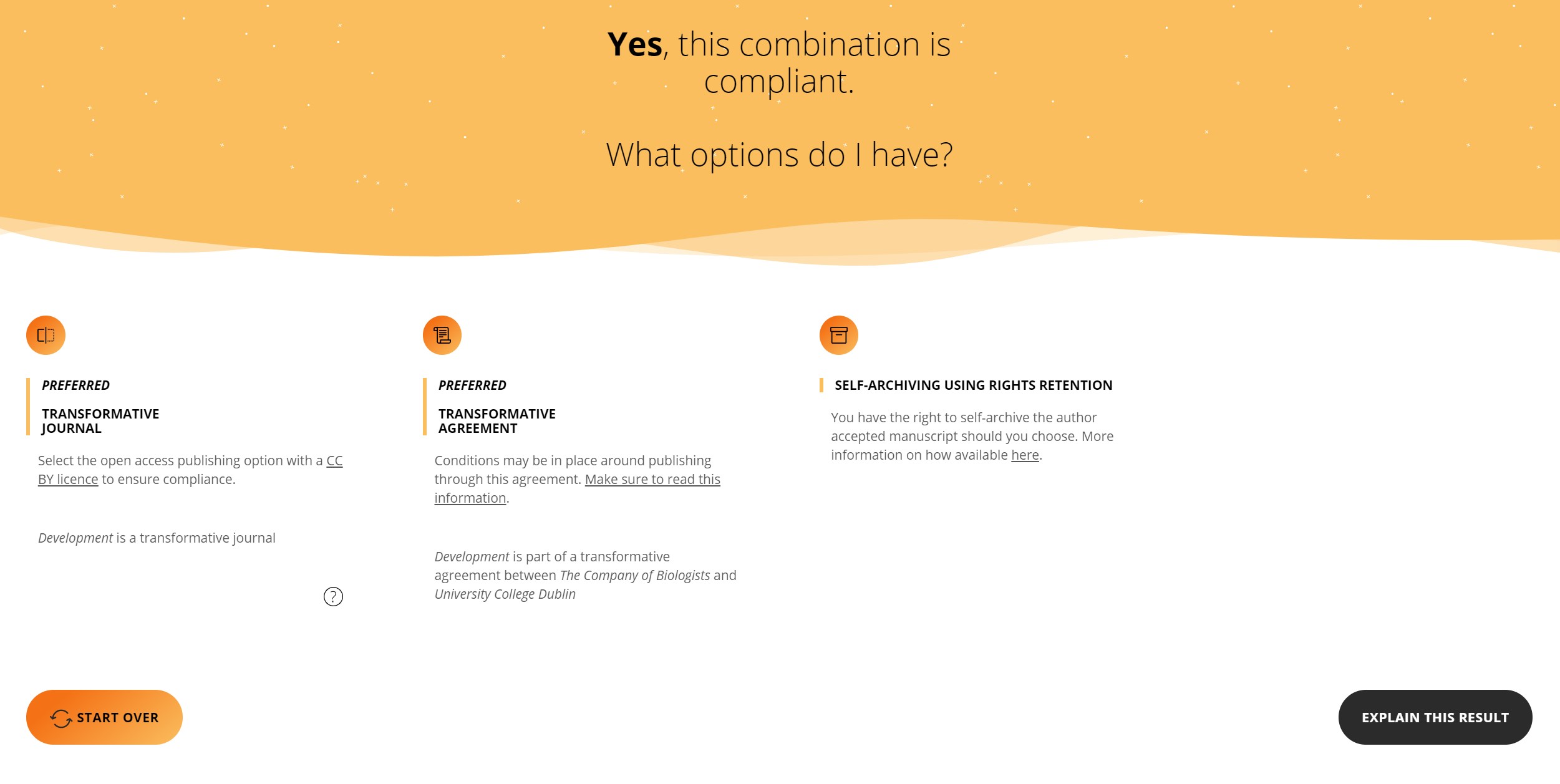
On the results page, a researcher will be shown all the available routes that enable compliance based on the combination of data they have entered. Where there are multiple routes to compliance available, it is for the researcher to choose which route to proceed by, although the JCT does visualise cOAlition S’s preference for routes that enable the Version of Record to be made open access. (See also related blog post: “4 things you should know about the Rights Retention Strategy and the Journal Checker Tool).
Where no route to compliance is available with the combination entered, the Journal Checker Tool provides suggestions on how to edit the search – for example, seeing if a coauthor at a different institution has access to a TA – to find a combination that enables compliance. Any route that doesn’t enable compliance isn’t shown within the result. However, you can see why the JCT thinks these routes don’t enable compliance via the “Explain Result” dropdown menu.
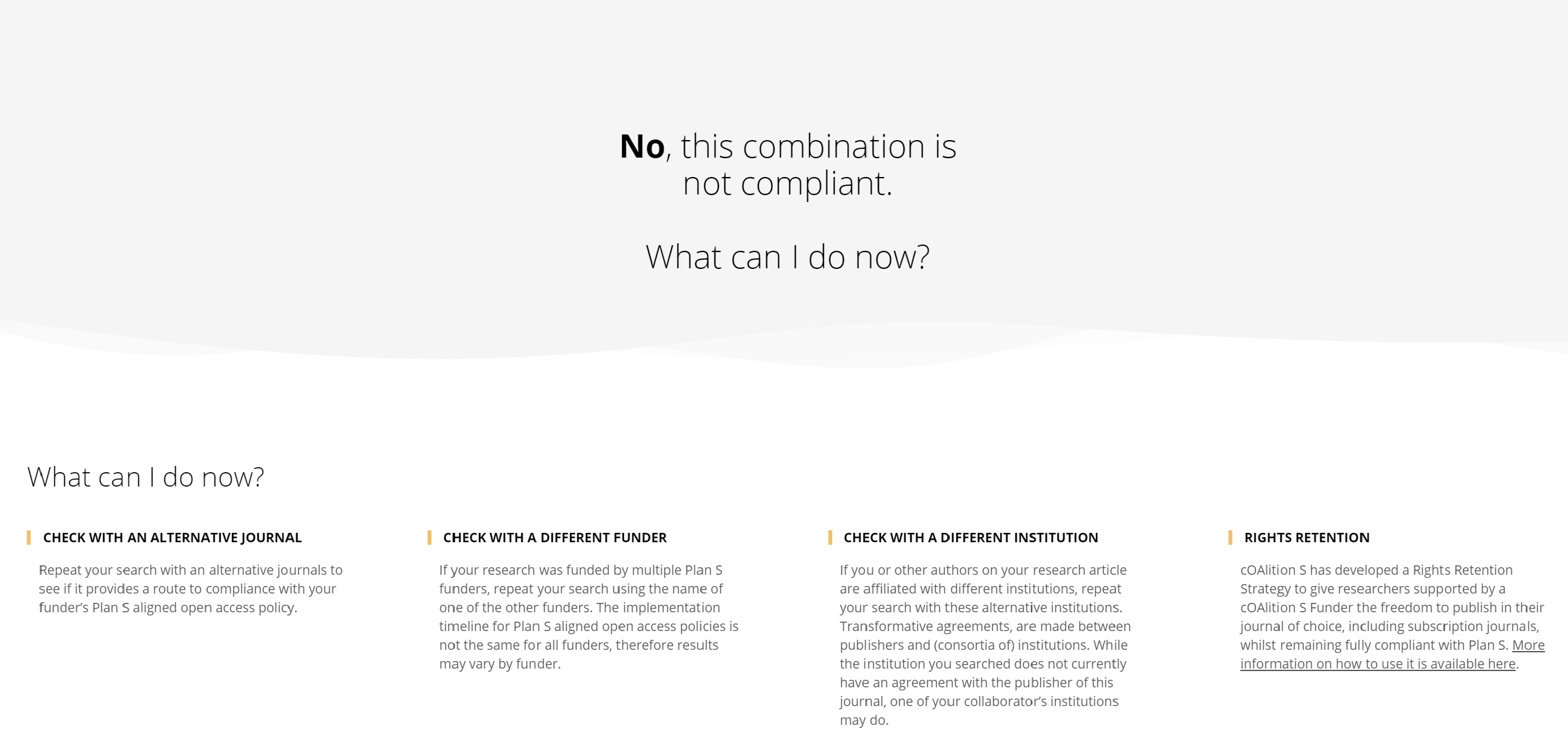
The data used in the JCT calculation is large and distributed across the global network. The JCT relies upon data from the Directory of Open Access Journals, Shareyourpaper.org Permissions, the ESAC Transformative Agreement Registry, Crossref and the Research Organization Registry Community (ROR). To improve the performance of the JCT we use local caches of some of this data that is regularly refreshed. As part of the development of the JCT we’ve developed an index at the journal and institution level of Transformative Agreement listed in the ESAC Agreement Registry and a list of cOAlition S approved Transformative Journals. These data sources are released today as part of the beta launch, under a CC-0 licence.
The beta phase: How can you help to improve the JCT?
As mentioned, the test phase is very important in getting feedback from the community about the tool. We’ll be using this feedback to improve the tool in the coming weeks and inform our development plans for the first half of 2021.
A vital part of the feedback will be improving the freshness of the source data that the JCT is dependent on. Getting this information will be a continuous process: as journals change policies or publishers; as transformative agreements are signed or renewed; and as new journals are formed. We have processes in place to monitor for some of these changes, others will require action from publishers and consortia such as applying to DOAJ or depositing a new transformative agreement in the ESAC Registry.
However, we welcome contributions from the community in this process by contacting us where they identify data issues that affect compliance results being shown. The JCT is a partnership between data sources, with data updates being made by the data sources themselves. For those looking to notify us of individual data errors please use the “Send us feedback” button on the website. For publishers or consortia looking to make changes at the portfolio level, we have a separate blog post on how to go about this.
What’s next?
The focus of the beta phase is on iterative changes to improve usability and data freshness. From January 2021, we’ll be working on new functions for the tool and building in the additional requirements that have been set out within the Plan S technical guidance.
Let us use mirror journals as an example. Plan S states that “Open Access journals must not have a mirror/sister subscription journal with substantial overlap in editorial board to avoid business models charging for both access and publication. Such journals will de facto be considered ‘hybrid’ journals.” Right now, we are not flagging these journals as non-compliant via the fully open access route, but that will change.
Another example is customising results based on cOAlition S Organisation’s implementation roadmap. While we’ve pulled in all organisation’s names, currently the only results that are tied to funder’s implementation plans are those relating to the Rights Retention Strategy (RRS). So there is more work to do to reflect organisations implementation of Plan S.
We’ve attempted to build a tool that cuts through the perceived and real complexities within Plan S, to support cOAlition S members’ and their researchers in delivering immediate open access to research. A tool that is able to respond to changes within the scholarly publishing environment and its approaches to delivering open access. A tool that will encompass your feedback.
We look forward to continuing this work with you and enabling the delivery of Plan S.
About the JCT development
The JCT was developed by Cottage Labs, in partnership with Antleaf consultancy, with the data providers Shareyourpaper.org Permissions and Directory of Open Access Journals (DOAJ). The project is overseen by a core team of Hannah Hope (Wellcome), Nora Papp Le Roy and Caroline Lambert (ESF) with support from the JCT Implementation Group (a subgroup of cOAlition S members).
Overview
The Rights Retention Strategy (RRS) ensures that researchers who have been funded by a cOAlition S Organisation will always be able to honour their funders’ Open Access (OA) policy. This is achieved by requiring researchers to give notice to publishers that an Author Accepted Manuscript (AAM) arising from their submission carries a CC BY licence, in accordance with their grant conditions. By way of example, Wellcome grantees must include the following text in all manuscript submissions:
“This research was funded in whole, or in part, by the Wellcome Trust [Grant number]. For the purpose of Open Access, the author has applied a CC BY public copyright licence to any Author Accepted Manuscript version arising from this submission”.
This post outlines how the Journal Checker Tool (JCT) will make the RRS information visible to researchers and how it will preference publishing options where the Version of Record (VoR) can be made Open Access.
1. Are all publishing venues Plan S compliant?
As all research articles submitted for publication from researchers whose funder has adopted the RRS will give notice to a publisher about the CC BY licence, all publishing venues can be deemed to offer a “Plan S compliant” publishing option. For the avoidance of doubt, the JCT is not asserting that the publisher policy supports the RRS. Rather, it indicates that the RRS allows researchers to self-archive the AAM with a zero-month embargo and a CC BY licence.
The only exception to this is if a publisher notifies cOAlition S that manuscripts which include the Rights Retention language will be rejected at submission. In such cases, the JCT will show that there are no compliant options, even if the publisher offers Transformative Arrangements, including Transformative Agreements (like Read and Publish deals) or Transformative Journals (TJs). To be clear, if manuscripts are rejected at submission because of the RRS language, they cannot then go on to be published through Transformative Arrangements.
To date, we are pleased to report that no publisher has indicated that they will systematically reject submissions because the submission includes the RRS language.
2. Preference for the VoR over the AAM
We recognise that the AAM version differs from the VoR. Not only does the latter contain all the changes from the copyediting process, journal formatting/branding etc., but it is also the version maintained and curated by the publisher, who has the responsibility to ensure that any corrections or retractions are applied in a timely and consistent way. For these reasons, our preferred option is to ensure that the VoR is made Open Access.
As such, when a publisher offers a Plan S-aligned way of making the VOR Open Access, the JCT will indicate this is the preferred route to compliance.
The screenshot below (Figure 1) shows an example of a journal which is part of a Transformative Agreement. Note how the Transformative Agreement option is shown as “Preferred” (compared to the option to make the AAM Open Access via the RRS).

Figure 1: How options making the VoR OA are preferenced in the JCT
Example: Immunology, a journal which is part of a Wiley Transformative Agreement, accessible to researchers at Cardiff University
3. Plan S-aligned publisher self-archiving policies
Some journals – such as those published by the Royal Society and the Microbiology Society – have explicit policies allowing all researchers to self-archive their AAMs, without embargo and with a CC BY licence.
To determine this, the JCT checks publishers’ self-archiving policies (via the Shareyourpaper.org permissions service) to see if they support compliance with Plan S. Where they do, the JCT displays the publisher’s policy as providing a route to compliance via self-archiving. In such cases, cOAlition S funded authors can therefore take advantage of such policies and deposit the AAM in a repository in compliance with their grant conditions. This approach does not rely on the RRS.
The publisher’s Plan S-aligned self-archiving route to compliance is shown along with any other options (such as Transformative Journal status, or relevant Transformative Agreements). Again, routes where the VoR can be made Open Access are flagged as preferred. This is shown in Figure 2 below.

Figure 2: JCT showing response to a Microbiology Society journal, where publisher-endorsed self-archiving, in line with Plan S, is supported
4. Ensuring the JCT is up to date
Over the coming weeks, we anticipate that some publishers will update their public policies relating to self-archiving, so they are fully aligned with Plan S.
For a publisher, the advantage of developing a Plan S-aligned self-archiving policy is that it affords them the opportunity to include the condition that the AAM is cross-referenced with the VoR. Such a requirement would be absent when AAMs are made available via the RRS route.
Where publishers do update their public policies, the JCT will reflect these changes via the integration with the Shareyourpaper.org permission service. However, if publishers wish to ensure that these changes are reflected as quickly as possible in the JCT, they should use the Shareyourpaper.org update request form. The form includes a bulk update option for those wishing to update a journal portfolio.
The previous data collection mechanism whereby publishers responded to the cOAlition S office and selected from a set of options, has been discontinued. This is partly to simplify the process – and provide a single source where self-archiving policies are discovered – and partly a recognition that the initial approach was not widely supported by publishers. Indeed, of the 153 letters sent, only 28 publishers (18%) responded with an “actionable” response. Most publishers did not respond, and of those who did, many did not provide an answer which could be incorporated into the JCT.
Conclusion
Complying with cOAlition S Organisations’ Open Access policies can look complicated. Not only are there multiple routes to compliance with funder policies, but some of these – such as Read and Publish deals – are only accessible to researchers at institutions which participate in these agreements. Other routes, like the RRS, apply even when the publisher’s own policy suggests otherwise.
To help navigate this complex landscape, cOAlition S has supported the development of the JCT and encouraged publishers to update their policies. With a clear focus on researcher needs, the JCT provides unambiguous advice to researchers on how they can comply with their funder’s Plan S-aligned Open Access policy when seeking to publish in any peer-reviewed journal.

